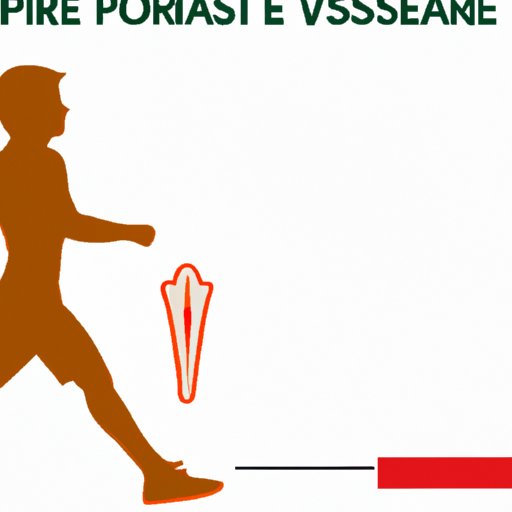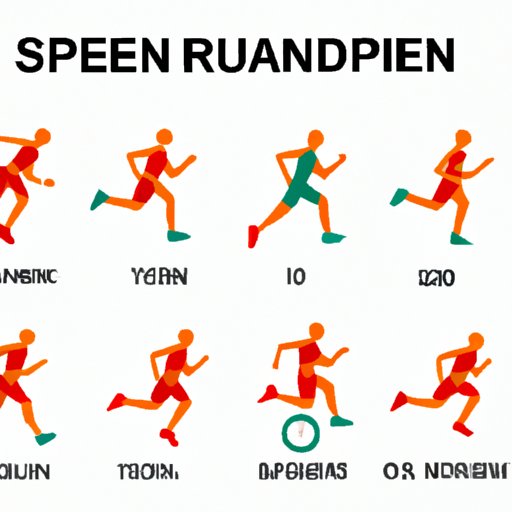I. Introduction
Running is an excellent way to stay in shape and improve cardiovascular health. Many people choose to run as a form of exercise, competition, or simply for recreational purposes. While running itself can be a relatively straightforward activity, it takes a certain level of expertise to master the art of running fast, and it’s not just about your speed, but also your endurance. In this article, we will explore how to run fast by discussing the importance of proper form, strength training exercises, tips to increase endurance, the role of a proper warm-up, the benefits of interval training, the role of nutrition, and how to develop a personalized training plan.

II. The Importance of Proper Form in Running Fast
Proper form is crucial for efficient running, and this is especially true when you want to run fast. Correct posture and alignment can reduce the energy you expend during each stride and minimize joint stress. Good form also improves running biomechanics, reducing the risk of injury. Some common mistakes people usually make include:
– Overstriding, which results in a braking action that impedes your forward motion.
– Slouching, which leads to reduced breathing capacity and increased strain on the core muscles.
– Swinging the arms across the body, causing unwanted cross-rotation and wasted energy.
The proper running form is to:
– Stand tall with your shoulders down and gaze forward.
– Make short and quick strides, landing on the middle or ball of your foot instead of your heel.
– Swing the arms at a 90-degree angle and in line with your body.
Maintaining proper form can be challenging, especially when you’re tired, but practicing good habits and utilizing the right techniques will help you improve over time.
III. Strength Training Exercises to Improve Running Speed
Strength training exercises improve running speed by strengthening the muscles used in running. Resistance training exercises can take less time than running and may be more efficient in building muscle mass. A few examples of strength-training exercises for runners include:
– Squats to strengthen the hamstrings, glutes, and quadriceps muscles.
– Lunges to increase hip stability and balance.
– Calf raises to strengthen the calf muscles.
– Deadlifts to strengthen the back, hamstrings, and glutes.
When incorporating strength training into your running routine, it’s best to do these exercises during the off days between runs. If you have a busy schedule, try to aim for at least two-three times per week and utilize manageable weights that ensure balance and correct posture.
IV. Tips to Increase Your Running Endurance
Running fast is not just about speed but also about endurance. Running endurance is the ability to run for a more extended period at a consistent pace. Endurance is easier to develop and maintain than speed as it takes time to build the muscles necessary to sustain speed. The following are tips to improve your running endurance:
– Start slowly and consistently and gradually increase your mileage as you get used to it.
– Focus on your breathing patterns and take deep breaths through your mouth and nose.
– Cross-train with other forms of aerobic exercise like cycling and swimming to improve overall cardio health.
Remember, the key to building endurance is consistency and making gradual changes in your workouts.
V. Why a Proper Warm-Up is Essential to Running Fast
A proper warm-up before running is critical. This is because it prepares your body for the stress of vigorous exercise, improves joint mobility, and reduces the risk of injuries. Some efficient warm-up exercises include:
– High knees and kickbacks to engage leg muscles.
– Lunges and squats to activate the core and lower body.
– Butt kicks and grapevines to improve overall mobility.
The ideal warm-up time before running fast is about 10-15 minutes, and it should be done at a low intensity to avoid overtaxing the muscles.
VI. The Benefits of Interval Training for Running Fast
Interval training combines high-intensity bursts of exercise with short rest periods to improve speed and endurance. Several interval training workouts can include:
– Sprint intervals of 30-60 seconds followed by 30 seconds of rest.
– Hill intervals. Running uphill at a fast pace and downhill slowly for recovery.
– Tempo runs. Focusing on sustaining a steady, fast pace for a more extended period.
Incorporating these workouts two-three times per week into your workout routine enables you to build not just speed but also endurance.
VII. The Role of Nutrition in Running Fast
Good nutrition is critical in providing the energy necessary to run fast. Runners must consume adequate macronutrients, including proteins, carbohydrates, and fats, for optimal running performance. A few tips include:
– Eating a balanced meal with proteins, healthy fats, and whole foods.
– Avoiding high sugar and high-fat foods as they lead to sluggishness and reduced energy levels.
– Drinking plenty of water to stay hydrated throughout the day.
The right nutrition also ensures that the body has the necessary minerals and vitamins necessary for good overall health.
VIII. How to Develop a Personalized Training Plan for Running Fast
A customized training plan is essential for achieving faster running times goals. The following tips can help you create a training plan that meets your specific needs:
– Determine your goals and the time frames you have to achieve them.
– Evaluate your running strengths and weaknesses.
– Schedule your workouts and incorporate adequate rest and recovery into your training routine.
Remember, your training plan should be individualized and reflect your personal goals and needs.
IX. Conclusion
Running fast requires diligence and hard work. Incorporating these tips into your running routine can help improve your speed and endurance safely and efficiently. Remember, the key is to work on your form, practice strength training, build endurance, warm up correctly, practice interval training, eat a balanced diet, and create a personalized training plan. By incorporating these steps into your running routine, you will take your running to the next level and experience the full benefits of running fast.
